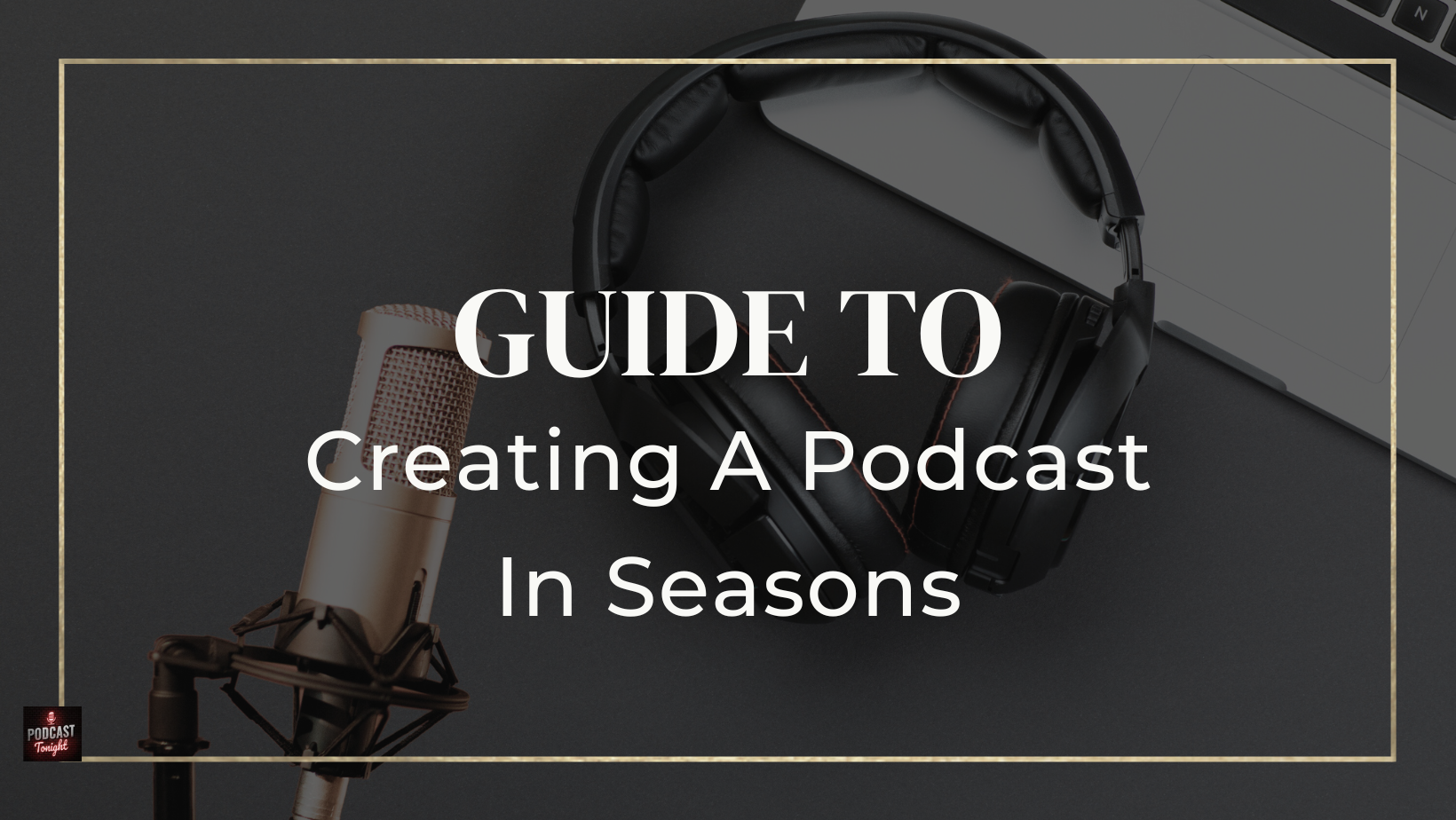A podcast is a digital audio file or series of files that can be downloaded or streamed from the internet. Listeners can subscribe to podcasts to receive new episodes automatically and can use various apps to download and listen to them on their devices. If you’re thinking about starting a podcast, the Guide to Creating a Podcast in Seasons is the ultimate resource to help you get started.
One of the key benefits of the guide is its focus on creating a podcast in seasons. This approach allows you to structure your content into a coherent and cohesive series of episodes, with a clear theme or story arc running through each season. This not only helps you to keep your listeners engaged and coming back for more, but it also makes it easier for you to plan and create content that resonates with your audience.
So why wait? Start reading today and take the first step toward creating a successful and impactful podcast!

What Is A Podcast In Seasons?
A “podcast in season” refers to a podcast that is currently producing new episodes as part of a specific season. Many podcasts release their episodes in seasons, with a set number of episodes released over a particular period of time. Typically, each season of a podcast will have a particular theme or focus, and the episodes will explore different aspects of that theme or topic.
When a podcast is “in season,” it means that new episodes are being released on a regular basis according to the season’s schedule. Podcasts can have multiple seasons, and each season can have a different length or number of episodes.
Listening to a podcast in season can be a great way to stay up to date with the latest content and keep track of new episodes as they are released. Many podcast apps allow you to subscribe to a podcast, which will automatically download new episodes when they become available, making it easy to stay on top of your favorite shows.
What Is The Advantage Of Having Seasons In Podcasts?
Structured format
Having seasons gives a podcast a structured format and allows the creators to plan out the content in advance. This can help ensure that the episodes flow together cohesively and that each season has a clear focus or theme.
Predictable release schedule
By releasing episodes in seasons, listeners know when to expect new episodes. This can help build a loyal audience and keep them engaged with the show.
Promotion and marketing
By taking breaks between seasons, podcast creators have more time to focus on marketing and outreach efforts. This could involve developing social media campaigns, building relationships with other podcasters, or planning live events.
When a new season of a podcast is released, it can attract new listeners – thus, helping increase the show’s visibility and reach a wider audience.

Fresh content
Having seasons allows podcast creators to take breaks in between seasons to recharge and come up with fresh ideas for new episodes. This can help prevent burnout and ensure that the content remains engaging and interesting.
Easier production
By producing episodes in batches for each season, it can be easier for podcast creators to plan, record, and edit the content. This can save time and effort and ensure that the quality of the content remains consistent.
Ability to experiment
With seasons, podcast creators have the opportunity to experiment with different formats, themes, and styles from one season to the next. This allows them to try out new ideas and see what resonates with their audience.
Improved planning and organization
By planning episodes in advance for each season, podcast creators can ensure that they have enough time to research topics, line up guests, and develop a cohesive narrative arc for the season. This can result in a higher quality of content and a more engaging listening experience for the audience.

Better work-life balance
Podcasting can be a time-consuming and often stressful endeavor. By having clear breaks between seasons, podcast creators can take time off to recharge, spend time with family and friends, and pursue other interests. This can help prevent burnout and ensure that they continue to produce high-quality content over the long term.
Improved listener engagement
Podcast creators can encourage listener engagement by soliciting feedback, answering questions, and soliciting guest suggestions that tie in with the season’s theme. This can help build a sense of community around the podcast and encourage listeners to become more invested in the show over time.
How To Write A Podcast In Seasons?
Define your topic and audience
To create a good podcast with seasons, you need to have a clear idea of the topic or theme you want to explore and the audience you want to reach. Spend time researching potential topics and niches that align with your interests and expertise, and consider the needs and preferences of your target audience. This will help you create content that is relevant, engaging, and valuable to your listeners.
Plan your seasons
Once you have a clear topic and audience, you can start planning your seasons. Decide on the number of episodes you want to produce per season and how long each episode will be.
Determine the # of episodes per season
To avoid feeling overwhelmed, begin with a manageable length for your podcast. Choose a season you can start, progress, and conclude satisfyingly for you and your audience. If you lack experience, avoiding being overly ambitious with your first project is best. Instead, start with a shorter format consisting of up to eight episodes. While some successful shows have 10-12 episodes, it’s crucial to ensure that you can maintain production quality at this length.
Create a schedule for when you will release episodes and stick to it. Consider the overall arc of the season and how each episode will contribute to that arc. This will help ensure that your content flows smoothly and keeps listeners engaged from start to finish.

Develop a narrative arc
A good podcast with seasons has a clear narrative arc that ties all episodes together. Develop a storyline that will run through the entire season, with each episode building on the previous one. This method not only aids in storytelling but also has practicality as new listeners may start from any episode. By creating interconnections between episodes, listeners are encouraged to go back and listen to the entire season.
Consider using cliffhangers or other hooks to keep listeners coming back for more. You might also consider incorporating recurring segments or themes that tie into the overall narrative arc.
Prepare a sequel and sustain engagement
To retain your audience during breaks between seasons, it’s essential to keep them informed about your upcoming projects. You can achieve this by announcing your current work in the last episode of the season or even before that.
In the interim, you can provide peeks at your upcoming work or produce extra episodes. It’s also a good idea to release teasers a month before your show’s launch to give your audience a preview of what to expect. This approach will ensure that your audience stays interested in your content and doesn’t forget about it.
Research and prepare
To create engaging and informative content, you need to research your topics thoroughly and prepare scripts for each episode. Consider inviting guests or experts to participate in your podcast to bring fresh perspectives and insights. This can help add variety to your content and keep listeners engaged. Take the time to rehearse your scripts and practice your delivery to ensure that your episodes are polished and professional.
When To Release Episodes?
The release of podcast episodes is not affected by whether or not the podcast has seasons. Rather, episodes are only released once they have been fully produced and edited. However, there are some variations when seasons are involved.
Seasons serve as a point of reference for listeners, who can expect new episodes to be released at specific times. This allows podcasters to focus on creating new content rather than worrying about distribution.
On the other hand, when podcasts do not have seasons, episodes may be released at any time, making it difficult for listeners to keep track. In this case, podcasters must adhere to a strict posting schedule and decide between releasing episodes in a random or specific order.

Take Your Podcast to the Next Level with Podcast in Seasons!
A beneficial method to promote your podcast is by adopting the podcasting in seasons strategy. This approach communicates to your audience that your podcast is active and producing new episodes. Utilizing this method can sustain the excitement around your podcast.
This guide is an excellent resource for anyone looking to produce high-quality content that engages and informs listeners. By following the steps outlined above, you can create engaging and informative content that keeps listeners coming back for more. However, it’s important to remember that creating a successful podcast requires ongoing effort, consistency, and creativity. With this guide as a starting point, you’ll be well on your way to building a loyal audience and achieving long-term success.


Leave a Reply